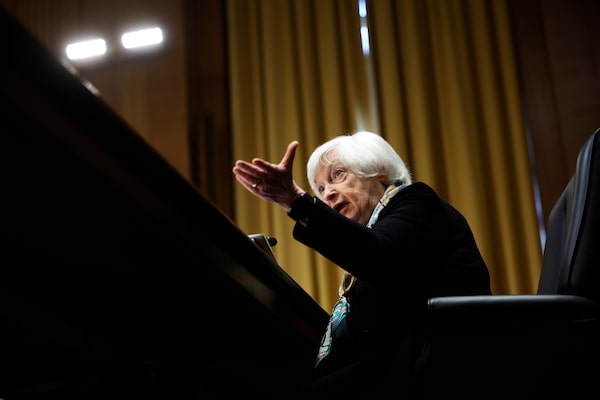
U.S. Treasury Secretary Janet Yellen testifies about the Biden administration's federal budget proposal on March 16 in Washington.Chip Somodevilla/Getty Images
It’s a bank run. No, a banking crisis. Or is it a panic, or a liquidity crisis?
Since the first rumbles of trouble in the financial system were felt a week ago, economists, investors and market watchers have struggled with the right terminology to describe exactly what’s happened.
The language around the shocking events that have unfolded since Monday has evolved as the situation worsened.
What started as recognized bank runs at Silicon Valley Bank and later Signature Bank, both of which were quickly shut down and put under control of U.S. federal regulators, then spread to more amorphous fears about the stability of other American regional banks, as well as the precarious fate of troubled Swiss banking giant Credit Suisse.
With that contagion of fear has come darker musings, with some evoking the spectre of a full-blown banking crisis and others drawing the inevitable comparisons to the early days of the 2008-09 global financial crisis. As if on cue, Thursday’s US$30-billion rescue of First Republic Bank by some of America’s largest financial institutions came 15 years to the day after the collapse of Bear Stearns, an early warning sign of the trouble that was to come.
Along the way, equity and debt markets have whipsawed wildly, adding to the confusion.
Yet if history has shown anything when it comes to financial mayhem, it’s that the first draft often gets it wrong.
“These things always get defined in retrospect, not in the moment,” said Eric Hilt, a professor of economics at Wellesley College in Massachusetts, who teaches American economic and financial history.
For one thing, he said, there is complete uncertainty about how broad or long-lasting this upheaval could turn out to be.
In other words, is this the early stages of a much deeper crisis? Or, as U.S. Treasury Secretary Janet Yellen and her counterparts at the Federal Reserve and the Federal Deposit Insurance Corp. have strained to put it, an unpleasant situation that the co-ordinated efforts of regulators have largely contained?
“This show of support by a group of large banks is most welcome, and demonstrates the resilience of the banking system,” the Fed, Treasury Department, FDIC and Office of the Comptroller of the Currency said in a joint statement released Thursday about the rescue of First Republic.
Prof. Hilt leans to the latter. He said the chaos being experienced by a small number of banks does not meet the standard of a “systemic financial crisis.” Instead, he described events of the past week as an “incipient panic” that is likely to be short lived.
“Like more historic panics, it’s starting in a particular class of institutions and other similar institutions with an observable similarity are seeing contagion, but at this point it’s not clear it’s going to become systemic,” he said.
He added that the 2008-09 financial crisis was rooted in fundamental problems in the U.S. financial system related to the collapse in house prices and exposure to toxic subprime mortgages. “SVB made some really bad, foolish bets on interest rates and exposed itself to risk,” Prof. Hilt said. “But it’s not on the scale of making gigantic, terrible loans on real estate.”
However, he acknowledged the line between panic and systemic crisis can be “a little bit slippery.”
Bond markets roiled by highest volatility since 2008
It’s certainly not the first time the world has struggled to define an era of financial chaos. Well into the economic shocks that began in 2007, the question of what to call the thing persisted.
It began as a “subprime mortgage crisis,” but came to be called a “credit crunch,” “liquidity crisis,” “global financial crisis” and the “Great Recession.” At one point, some observers even took to calling it a “crecession” – a merger of credit crunch and recession.
The current confusion stems in part from the fact that we don’t yet know what troubles might lurk on the balance sheets of other banks. The sharp increase in interest rates over the past year and other credit tightening measures have brought a great unravelling of the cheap money era.
As J.P. Morgan chief economist Michael Feroli said this week: “There’s an old saying: Whenever the Fed hits the brakes, someone goes through the windshield.” It’s still unclear how many other companies and financial institutions didn’t have their seat belts on.
Despite that uncertainty, many are still loath to call this a banking crisis. Beata Caranci, chief economist at Toronto-Dominion Bank, described the turmoil as a “confidence crisis” in a video posted on the TD Economics website, saying it is specifically related to U.S. regional banks, not the broader economy.
Torsten Slok, chief economist at Apollo Global Management, described the bank failures and ensuing uncertainty as “a financial accident,” one that has been driven by tighter credit conditions and that could make a “hard landing” for the U.S. economy inevitable.
Likewise, Megan Greene, chief economist with the Kroll Institute, said in a note Friday that while “spidey senses” are going off among analysts who experienced the 2008 crisis, the instability this time is limited to “idiosyncratic cases” that reflect liquidity issues, not solvency worries, as was the case 15 years ago.
That said, she added that the situation still has the potential to deteriorate as market anxieties mount.
“Bank runs are a question of psychology and Global Wall Street doesn’t seem to be in the mood to discern between idiosyncratic cases or between liquidity versus solvency problems,” Ms. Greene wrote. “Just because we are not in a banking crisis does not mean we can’t land there in the end. Markets have a way of generating self-fulfilling prophecies.”
 Jason Kirby
Jason Kirby